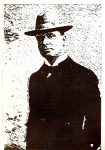
You will be wanting to know what prize Lars Talc found at the end of Bewg’s treasure trail. It was a minuscule horn, or tusk, which – according to the hand-written leaflet in which it was enwrapped – held certain talismanic properties. It was little bigger than the nail of Talc’s little finger, and was burnt sienna in colour.
Horn is different from bone. It is composed of coagulated, or thickened, albumen, gelatine, and phosphate of lime. It contains just enough of the lime to make it hard without being too brittle, and just enough of gelatine to render it easily cut and moulded when heated.
Most horns have a bony core, which is got out by soaking them in water for five or six weeks. This core can be ground up and made into little crucibles called cupels, used for melting gold and silver in. The tips of the horns, which are solid, are then sawn off, to be used for knife handles, buttons, &c. The remainder, or hollow part, is easily softened by soaking it in boiling duckpond water for half an hour, when it is slit open with a knife, spread out flat, and pressed between monstrous iron plates. If the “flats”, as they are called, are pressed very hard, they can easily be separated into several thin plates, which are scraped and smoothed and sometimes put into lanterns instead of glass. In olden times horn plates were used for window-glass. In the manufacture of combs and other things, horn is pressed but little, as too much pressure causes the teeth to split. It is easily coloured so as to look like tortoiseshell, from which sometimes it can be scarcely distinguished.
Horn when heated can be moulded into almost any shape, which it will keep when cold. In making knife and fork handles, buttons, and other small things, the pieces are cut of the right size, softened in hot water, and then screwed up in moulds, which shape the horn and press upon it any letters or figures that may be on the inside of the moulds. In about twenty minutes the horn is taken out and is then ready to be polished, which is done with rotten stone and oil.
Lars Talc’s prize horn, however, had been subjected to no such manufactory impulses, and Bewg’s leaflet warned that it must remain whole, and pristine, or it would no longer serve as a talisman.
The various lights under which a horn may be looked at have given rise to a vast number of words in language, not just Finnish. Horn may be regarded as a projection, a climax, a badge of strength, power, or vigour, a tapering body, a spiral, a waxy object, a bow, a vessel to hold withal or to drink from, a smooth hard material not brittle, stony, metallic, or wooden, something sprouting up, something to thrust or push with, a sign of honour or pride, &c.
From the shape, we find words such as kernel and granum, grain and corn. From the curve of a horn, corona and crown. From the spiral, crinis, meaning ringlets or locks. From its being the highest point comes our crown, perhaps, in the sense of the top of the head. For its sprouting up and growing, we have keren, cornu, cresco, grandis, grass, great, groot. For its curving, curvus is probably from the root horn in one of its forms. Corvus, cornix, and crow (perhaps also raven, which may have been craven) bear a striking resemblance to cornu and curvus. So also crane, heron, and herne. Why these birds should derive their names from horn we cannot presume to say. The tree cornel is said to derive its name from the hard horn-like nature of its wood, and the corns of the foot perhaps for the same reason. Corner is so called from its shape. Possibly, although unlikely, grin may mean to curve up the ends of the mouth like horns. In Switzerland, they call a mountain horn. Herna is a horn-like crag. And what are we to make of hoon?
Sarvi, torvi, and tuntosarvi are Finnish words for horn.
Bewg’s leaflet did not describe in any detail how the tiny burnt sienna horn acted as a talisman. In any case, all forms of superstition were anathema to Lars Talc, who had devoted one of his more uproarious essays to the subject. And yet he was extremely pleased with his prize, and carried it with him where’er he roamed during the final two weeks of his life.
